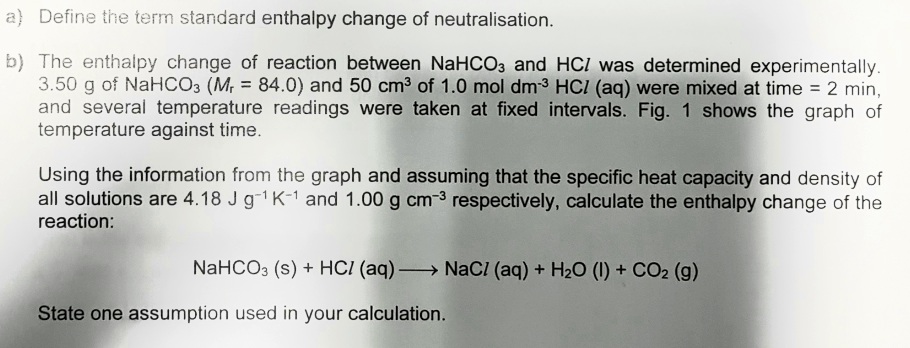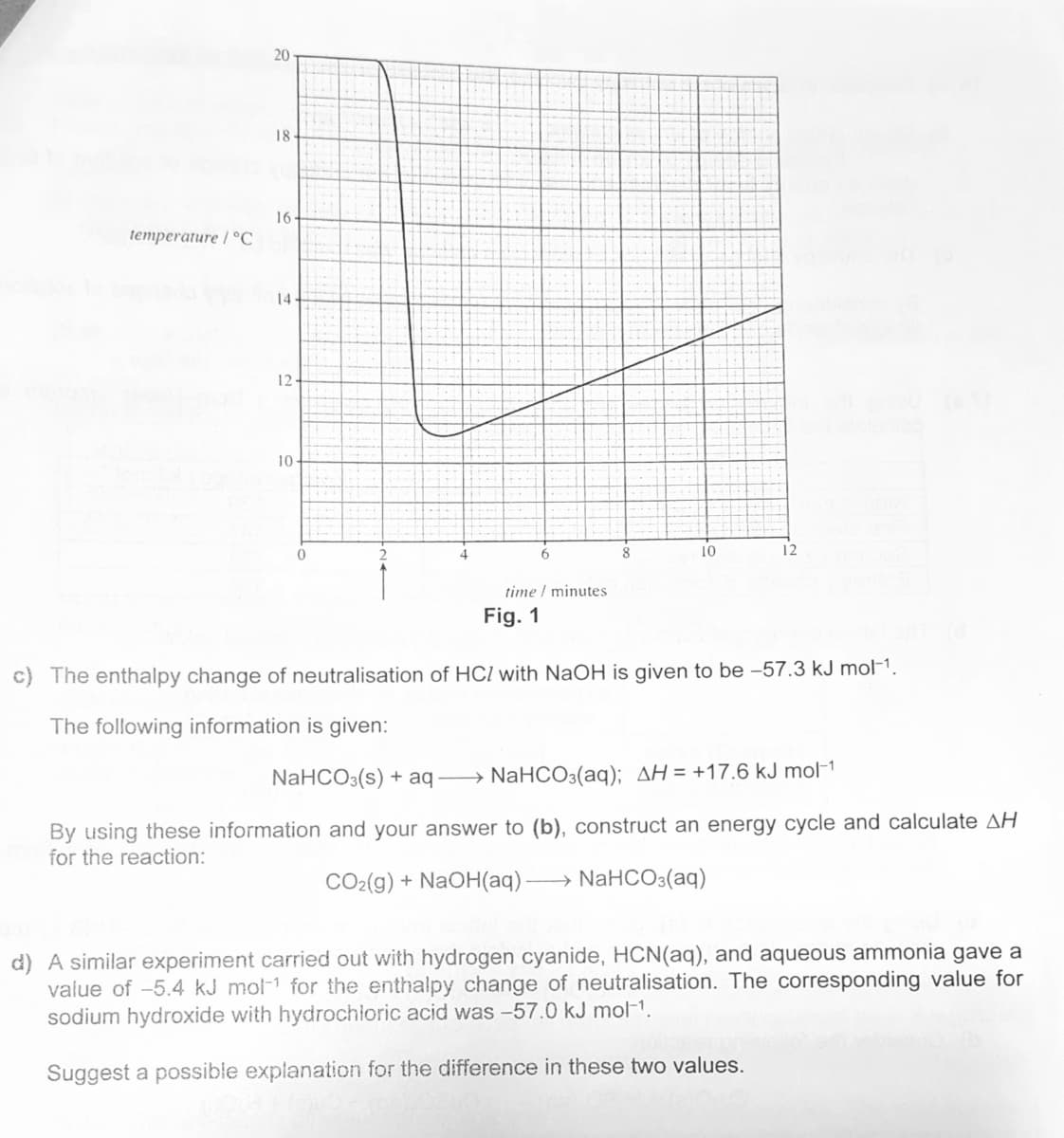a} Define the term standard enthalpy change of neutralisation. b) The enthalpy change of reaction between NaHCO3 and HCI was determined experimentally. 3.50 g of NaHCO3 (M, = 84.0) and 50 cm³ of 1.0 mol dm 3 HCI (aq) were mixed at time = 2 min, and several temperature readings were taken at fixed intervals. Fig. 1 shows the graph of temperature against time. Using the information from the graph and assuming that the specific heat capacity and density of all solutions are 4.18 J g1K-1 and 1.00 g cm-3 respectively, calculate the enthalpy change of the reaction: NaHCO3 (s) + HCI (aq) NaCI (aq) + H2O (1) + CO2 (g) State one assumption used in your calculation.
a} Define the term standard enthalpy change of neutralisation. b) The enthalpy change of reaction between NaHCO3 and HCI was determined experimentally. 3.50 g of NaHCO3 (M, = 84.0) and 50 cm³ of 1.0 mol dm 3 HCI (aq) were mixed at time = 2 min, and several temperature readings were taken at fixed intervals. Fig. 1 shows the graph of temperature against time. Using the information from the graph and assuming that the specific heat capacity and density of all solutions are 4.18 J g1K-1 and 1.00 g cm-3 respectively, calculate the enthalpy change of the reaction: NaHCO3 (s) + HCI (aq) NaCI (aq) + H2O (1) + CO2 (g) State one assumption used in your calculation.
Chemistry
10th Edition
ISBN:9781305957404
Author:Steven S. Zumdahl, Susan A. Zumdahl, Donald J. DeCoste
Publisher:Steven S. Zumdahl, Susan A. Zumdahl, Donald J. DeCoste
Chapter1: Chemical Foundations
Section: Chapter Questions
Problem 1RQ: Define and explain the differences between the following terms. a. law and theory b. theory and...
Related questions
Question
Full solution pls

Transcribed Image Text:a) Define the term standard enthalpy change of neutralisation.
b) The enthalpy change of reaction between NaHCO3 and HCI was determined experimentally.
3.50 g of NaHCO3 (M, = 84.0) and 50 cm3 of 1.0 mol dm-3 HCI (aq) were mixed at time = 2 min,
and several temperature readings were taken at fixed intervals. Fig. 1 shows the graph of
temperature against time.
Using the information from the graph and assuming that the specific heat capacity and density of
all solutions are 4.18 J g-1 K-1 and 1.00 g cm-3 respectively, calculate the enthalpy change of the
reaction:
NaHCO3 (s) + HCI (aq) → NaCI (aq) + H2O (I) + CO2 (g)
-
State one assumption used in your calculation.

Transcribed Image Text:20
18
16
temperature / °C
14
12-
10
10
12
time / minutes
Fig. 1
c) The enthalpy change of neutralisation of HCl with NaOH is given to be -57.3 kJ mol-1.
The following information is given:
NaHCO3(s) + aq→ NaHCO3(aq); AH = +17.6 kJ mol-1
By using these information and your answer to (b), construct an energy cycle and calculate AH.
for the reaction:
CO2(g) + NaOH(aq)
→ NaHCO3(aq)
d) A similar experiment carried out with hydrogen cyanide, HCN(aq), and aqueous ammonia gave a
value of -5.4 kJ mol-1 for the enthalpy change of neutralisation. The corresponding value for
sodium hydroxide with hydrochioric acid was -57.0 kJ mol-1.
Suggest a possible explanation for the difference in these two values.
Expert Solution
This question has been solved!
Explore an expertly crafted, step-by-step solution for a thorough understanding of key concepts.
This is a popular solution!
Trending now
This is a popular solution!
Step by step
Solved in 3 steps

Knowledge Booster
Learn more about
Need a deep-dive on the concept behind this application? Look no further. Learn more about this topic, chemistry and related others by exploring similar questions and additional content below.Recommended textbooks for you

Chemistry
Chemistry
ISBN:
9781305957404
Author:
Steven S. Zumdahl, Susan A. Zumdahl, Donald J. DeCoste
Publisher:
Cengage Learning

Chemistry
Chemistry
ISBN:
9781259911156
Author:
Raymond Chang Dr., Jason Overby Professor
Publisher:
McGraw-Hill Education

Principles of Instrumental Analysis
Chemistry
ISBN:
9781305577213
Author:
Douglas A. Skoog, F. James Holler, Stanley R. Crouch
Publisher:
Cengage Learning

Chemistry
Chemistry
ISBN:
9781305957404
Author:
Steven S. Zumdahl, Susan A. Zumdahl, Donald J. DeCoste
Publisher:
Cengage Learning

Chemistry
Chemistry
ISBN:
9781259911156
Author:
Raymond Chang Dr., Jason Overby Professor
Publisher:
McGraw-Hill Education

Principles of Instrumental Analysis
Chemistry
ISBN:
9781305577213
Author:
Douglas A. Skoog, F. James Holler, Stanley R. Crouch
Publisher:
Cengage Learning

Organic Chemistry
Chemistry
ISBN:
9780078021558
Author:
Janice Gorzynski Smith Dr.
Publisher:
McGraw-Hill Education

Chemistry: Principles and Reactions
Chemistry
ISBN:
9781305079373
Author:
William L. Masterton, Cecile N. Hurley
Publisher:
Cengage Learning

Elementary Principles of Chemical Processes, Bind…
Chemistry
ISBN:
9781118431221
Author:
Richard M. Felder, Ronald W. Rousseau, Lisa G. Bullard
Publisher:
WILEY